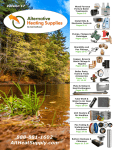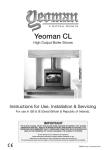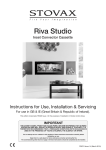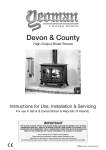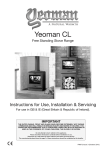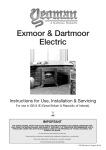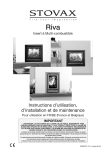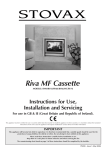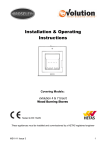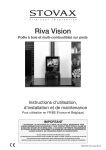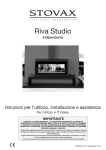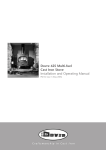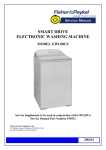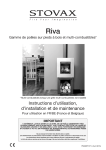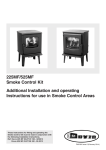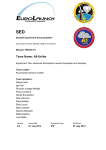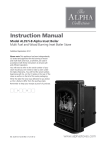Download Yeoman YM-W9302HC Operating instructions
Transcript
Exmoor/Exe/Devon/County Free Standing Stove Instructions for Use, Installation & Servicing For use in GB & IE (Great Britain & Republic of Ireland). IMPORTANT THE OUTER CASING, FRONT AND GLASS PANEL BECOME EXTREMELY HOT DURING OPERATION AND WILL RESULT IN SERIOUS INJURY AND BURNS IF TOUCHED. IT IS THEREFORE RECOMMENDED THAT A FIREGUARD COMPLYING WITH BS 8423:2002 IS USED IN THE PRESENCE OF YOUNG CHILDREN, THE ELDERLY OR INFIRM. Do not attempt to burn rubbish in this appliance. Please read these Instructions carefully before installation or use. Keep them in a safe place for future reference and when servicing the fire. The commissioning sheet found on page 3 of these instructions should be completed by the Installer. PM943 Issue 1 (July 2013) Contents Exmoor/ Exe/ Devon/ County - Freestanding Stove Range Covering the following models: YM-EXM-W1/YM-EXM-MF1/YM-EXM-WLC1/YM-EXM-MFLC1/YM-EXE-W1/YM-EXE-W2/YM-EXE-WLC1/YM-EXE-WLC2/YM-EXE-MF1/ YM-EXE-MF2/YM-EXE-MFLC1/YM-EXE-MFLC2/YM-DEV-W1/YM-DEV-W2/YM-DEV-WLC1/YM-DEV-WLC2/YM-DEV-WHC1/YM-DEV-WHC2/ YM-DEV-MF1/YM-DEV-MF2/YM-DEV-MFLC1/YM-DEV-MFLC2/YM-DEV-MFHC1/YM-DEV-MFHC2/YM-COU-W1/YM-COU-W2/YM-COU-WLC1/ YM-COU-WLC2/YM-COU-WHC1/YM-COU-WHC2 Appliance Commissioning Checklist.......................3 User Instructions........................................................4 Getting Started............................................................................ 4 User Instructions......................................................................... 6 Care & Maintenance................................................................... 9 Troubleshooting.......................................................12 Installation Instructions...........................................14 Installation Checklist.................................................................. 14 Pre-Installation Instructions....................................................... 18 Installing the Appliance............................................................. 20 Commissioning.......................................................................... 23 Maintenance & Servicing.........................................25 Technical Appendix..................................................30 Spare Parts List......................................................................... 34 Service Records........................................................................ 38 2 To receive your Extended Warranty your Yeoman appliance must have been purchased from our Expert Retailer Network and registered within one month of purchase or installation. Please note that all warranties are effective from the date of purchase. Any Yeoman product purchased outside of our Extended Retailer Network, or not registered within the stated time will carry a standard 12 month warranty. It is a condition of the Extended Warranty that the installation complies with the relevant Building Regulations and is carried out by a suitably trained and qualified individual (HETAS in the UK or equivalent in other countries) with the certificate of installation and the Commissioning Report on Page 3 completed and retained by the end user. Full terms and conditions are detailed in the Warranty Statement on the Yeoman website www.yeomanstoves.co.uk. In the event of any conflict of information the wording on the website shall prevail. Important Note: Should any problems be experienced with your product, claims must first be submitted to the Expert Retailer where the appliance was purchased from who will offer immediate assistance or contact Yeoman on your behalf. Appliance Commissioning Checklist To assist us in any guarantee claim please complete the following information:Retailer appliance was purchased from: Name: Address: Telephone number: Essential information - MUST be completed: Date Installed: Model Description: Serial Number: Installation Engineer: Company Name: Address: Telephone number: Commissioning Checks - to be completed and signed: Is flue system correct for the appliance: YES NO Flue swept and soundness test complete: YES NO Smoke test completed on installed appliance YES NO Spillage test completed YES NO Use of appliance and operation of controls explained YES NO Clearance to combustible materials checked YES NO Instruction book handed to customer YES NO CO Alarm Fitted YES NO Signature: ............................................................................ Print Name: .......................................................................... 3 Getting Started Welcome Congratulations on purchasing your Yeoman Stove, if installed correctly Yeoman hope it will give you many years of warmth and pleasure for which it was designed. The purpose of this manual is to familiarise you with your stove, and give guidelines for its installation, operation and maintenance. If, after reading, you need further information, please do not hesitate to contact your Yeoman retailer. 1.10 The chimney must be swept at least once a year. See Section 12. 1.11 Do not connect, or share, the same flue or chimney system with another appliance. SERIAL NUMBER 1.12 This number is required when ordering spare parts or making warranty claims. It is found on the appliance data plate behind the rear left hand side of the appliance and can be rotated outwards, see Diagram 1. 1. General Points 1.1 Before installation and/or use of this appliance please read these instructions fully and carefully to ensure that you have fully understood their requirements. The appliance must be fitted by a registered installer†, or approved by your local building control officer. 1.2 Only use for domestic heating in accordance with these operating instructions. 1.4 You must burn only approved fuels. Do not use with liquid fuels or as an incinerator. 1.6 Appliance surfaces become very hot when in use. Use a suitable fireguard* if young children, elderly or infirm persons are present. Yeoman offer firescreens, sparkguards and hearthgate systems for protection. Your Yeoman Retailer can advise you about these products. Do not place photographs, TV’s, paintings, porcelain or other combustible items on the wall or near the appliance. Exposure to hot temperatures will cause damage. Do not place furniture or other items such as drying clothing closer than 1m from the front of this appliance. WARNING: Extra fuel should not be stored on or next to the appliance. Only keep enough fuel for immediate use nearby and never leave the appliance unattended for long periods with any combustible material in close proximity. 1.7 Extractor fans or cooker hoods must not be placed in the same room or space as this can cause appliance to emit fumes into the room. 1.8 Do not obstruct inside or outside ventilation required for the safe use of this appliance. 1.9 Do not make unauthorised changes to the appliance. *In the U.K. these products must conform to the latest edition of BS 8423, Fireguards for use with solid fuel appliances. If appliance is operating unattended they must conform to the latest edition of BS 3248 † Registered on the Competent Persons Scheme (GB only see page 32/ INFO (Republic of Ireland). 4 Data Plate All local regulations, including those referring to national and European Standards need to be complied with when installing the appliance. 1.3 1.5 1 AIR CONTROLS Triple Air Systems This appliance has a triple air system providing cleaner burning, and greater efficiency and control, see Diagram 2. 1) Airwash - air drawn over the window cleans the glass. The source of Primary Combustion air when burning wood. 2) Primary Air - for use initially when establishing fires. 3) Cleanburn - Secondary air is preheated through a heat exchanger to combust unburned hydrocarbons, providing a cleaner and more efficient burn. 2 1 3 2 Getting Started AIRWASH & PRIMARY AIR CONTROLS WARNING 1.13 Use the stub on the end of the tool or a gloved hand to operate air controls. 3 Properly installed, operated and maintained, this appliance will not emit fumes into the room. Occasional fumes from de-ashing and refuelling may occur. Airwash Control CLOSE OPEN 1 DOOR 2 DOOR Primary Control Primary Control Open Open Close Open SECONDARY AIR CONTROLS 4 1 DOOR SECONDARY AIR CONTROLS If fume emission does persist: • Open doors and windows to ventilate the room. • Leave the room. • Allow fire to burn out and safely dispose of fuel from the appliance. • Check for chimney blockage and clean if required. • Do not attempt to relight until the cause of the emission has been identified and corrected • If necessary seek expert advice. • All open flued appliances can be affected by temporary atmospheric conditions which may allow fumes to enter the house. Because of this an electronic carbon monoxide detector conforming to the latest edition of BSEN50292 must be fitted in the same room as the appliance. The existence of an alarm must not be considered a substitute for ensuring regular servicing and maintenance of the appliance and chimney system. 2. Using the Appliance for the First Time DO NOT OPEN THE DOOR WITH BARE HANDS DO NOT OPEN THE DOORS WHEN THE FIREBOX IS FULL OF FLAMES - WAIT FOR THEM TO DIE DOWN. To Open and Close Drop tool over knob to fit. Rotate 90º to open and close, see Diagram for direction. Lift up to remove 1 DOOR IF THE ALARM SOUNDS FOLLOW THE INSTRUCTIONS GIVEN UNDER WARNING ABOVE. DOOR HANDLE 5 Persistent fume emission is potentially dangerous and must not be tolerated. 2 DOOR Secondary Control Pull - OPEN Push - CLOSE 2 DOOR 2.1 To allow the appliance to settle, and fixing glues and paint to fully cure, operate the appliance at a low temperature for first few days. 2.2 Do not touch the paint during the first period of use. 2.3 During this time the appliance may give off some unpleasant odours. Keep the room well ventilated to avoid a build-up of fumes. 2.4 Please be aware that, during use, rope seals may discolour. This is normal. Open Open 5 Getting Started/User Instructions 3. Recommended Fuels 4. Lighting the Appliance 3.1 Wood Logs: Burn only seasoned timber with a moisture content of less than 20%. To ensure this allow cut wood to dry for 12 to 18 months. 6 4.1 Whether using wood or solid fuel the process for lighting the appliance is the same. 4.2 For best results manually set air controls as shown in Diagram 7. 7 Wood Length Air Wash: Fully Open Primary Air: Fully Open Appliance Secondary Air: Fully Open Wood Length Exmoor 250mm Exe 300mm Devon 350mm County 400mm Air Wash: Fully Open Poor quality timber: — Causes low combustion efficiency — Produces harmful condensation — Reduces effectiveness of the airwash and life of the appliance Do not burn construction timber, painted, impregnated / treated wood, manufactured board products or pallet wood. 3.2 Solid fuel: — Burn only anthracite or manufactured briquette smokeless fuels listed as suitable for use with closed heating appliances Do not burn bituminous coal, ‘petro-coke’ or other petroleum based fuels as this will invalidate the product guarantee. 3.3 Primary Air: Fully Open Secondary Air: Fully Open 4.3 Place firelighters, or paper, and dry kindling wood on the grate (Multi-fuel version) or firebed (Woodburning version). A successful fire initially requires plenty of kindling to establish a hot firebox and warm the chimney to aid flue performance. 4.4 Light the paper or firelighters, see Diagram 8. 8 Fuel consumption. As tested at nominal heat output to the requirements of EN 13240: 2001 for intermittent operation: Fuel Consumption Kg/Hour Wood (300mm long) Kg/Hour Briquette Smokeless Fuel Exmoor 1.7 0.7 Exe 1.7 0.7 Devon 2.7 1.5 County 3.9 2.1 Description 3.4 6 4.5 Leave the door slightly open as the fire establishes and the glass warms to avoid build up of condensation. For advice on suitable solid fuels contact your local approved coal merchant*. *In the U.K: A number of factors can affect the performance of the appliance. See Troubleshooting Section for details. • Visit their web site at www.solidfuel.co.uk • Ring the Solid Fuel Association advice line on 0845 601 4406 for details User Instructions 4.6 Add larger pieces of wood. Do not use full sized logs at this stage, build up gradually in size. Too many logs may smother the fire. . Do not load fuel above the log guard and the Secondary Combustion Inlets at the back of the firebox, see Diagram 9. 9 —Close the door. Wood burns best on a bed of ash (approx. 25mm (1") deep). Rake the embers evenly over the firebed and open the Airwash Control fully for a few minutes before re-fuelling. 5.2 Do not refuel when a large amount of flames are in the firebox as this could cause smoke or flames to spill into the room. 5.3 Close the doors immediately after refuelling. 5.4 Burn new logs at a high temperature for a few minutes before adjusting the Airwash Control. Refuel little and often for clean, efficient burning. More Airwash will increase the heat output, burn fuel more quickly and will help keep the glass clean. Small amounts of Primary Air can sometimes help to maintain a hot fuel bed. 5.5 Do not burn large amounts of fuel with the Airwash Control closed for long periods of time. This reduces the glass cleaning effect of the Airwash and causes tars and creosotes to build-up in the appliance and flue system. 5.6 When in use, burning the appliance at a high temperature for a short period also reduces tars and creosotes. 5.7 Experience establishes settings to suit personal preference. Secondary Combustion holes Log Guard Do not leave the door open as this could over-fire and damage the appliance. 5. Running the Appliance Smoke Control version Burning Wood 5.8 5.1 Leave the Secondary Air fully open. 5.2 Close the Primary air control and use the Airwash to control the burn rate when appliance is at operating temperature, see Diagram 10 10 Some appliances have been independently tested to PD6434 and have been exempt from the controls that generally apply in smoke control areas hence are considered suitable for use in Smoke Control Area when burning wood and ONLY when fitted with the relevant Smoke Control kit . See Section 15 - Optional Extras. Contact your retailer for more information. Air Wash: Fully Open Converting Woodburning models Primary Air: Closed 5.9 To burn smokeless fuels efficiently in a woodburning appliance a cast iron multi-fuel kit must be fitted. Multi-fuel kit part numbers: Secondary Air: Fully Open Air Wash: Fully Open Primary Air: Closed Stove Part No. Exmoor YM-EXM-MFKIT Exe YM-EXE-MFKIT Devon YM-DEV-MFKIT County YM-COU-MFKIT Only for use with recommended fuels, see Installation Instructions for full fitting details. Secondary Air: Fully Open 7 User Instructions 5.13 When in use, burning the appliance at a high temperature for a short period reduces tars and creosotes. Multi-fuel Stove 5.10 To burn wood and smokeless fuels a cast iron multi-fuel kit must be fitted. Allow the fire to become established before adding the solid fuel, see section 4. —Set air controls, see Diagram 11. 5.11 To burn solid fuel efficiently it is best to control the combustion using the Primary air control only. 5.14 Only anthracite or smokeless fuels suitable for use in closed appliances must be burned in this appliance. 5.15 Do not burn bituminous coal, ‘petro-coke’ or other petroleum based fuels as this invalidates the product guarantee. 5.16 Do not load fuel above the log guard and the Secondary Air Inlets at the back of the firebox, see Diagram 9. Shut Down 11 Air Wash: 25% Open Primary Air: Adjust Secondary Air: Fully Closed 5.17 If there is still burning fuel in the firebox, Yeoman do not recommend shutting down the air controls completely unless there is a chimney fire in progress (see section 9 for advice). Closing the controls during the burning process will cause poor combustion and could lead to a build up of gases that could ignite dangerously. 5.18 Always have enough air entering the stove to maintain some flame within the firebox. 5.19 If it is necessary to shut down the appliance then run on a high setting until all of the fuel has been burnt before closing the air controls. Air Wash: 25% Open Primary Air: Adjust Secondary Air: Fully Closed 6. Extended Burning 6.1 It is possible to get the appliance to burn for extended periods of time. In order to do this: — De-ash prior to final refuelling. — Burn new fuel at a high temperature for a few minutes before adjusting the Primary Air Control. 5.10 De-ash the grate before re-fuelling (see User Instructions, Section 7). Open the Primary Air Control fully to establish a glowing bed before adding new fuel. Burn new fuel at a high temperature for a few minutes before adjusting the Primary Air Control to the desired setting. Refuel little and often for clean, efficient burning. When burning solid fuel more primary air will increase the heat output and burn the fuel more quickly. A small amount of Airwash can sometimes help to keep the glass clean but will reduce efficiency. — Set air controls to low combustion settings. This will gradually blacken the glass but it will clear when operated at a high temperature for a short period. 7. Ash Removal Always have the Secondary Air Control shut when burning solid fuel to ensure the maximum efficiency from the appliance. 7.1 Wood versions only. —Open Door(s). —Leave a layer of ash to start the new fire on. Wood burns best on a bed of ash (approx. 25mm (1") deep). — Remove ash with a small shovel and place into a Stovax Ash Caddy (Stovax Part No. 4227) or other suitable container. Do not place hot ash in any container made from plastic or any other combustible material. —De-ash at least once a week. 5.11 Experience establishes settings to suit personal preference. 5.12 Do not burn large amounts of fuel with the Primary Air Control on a low combustion setting for long periods of time. This reduces the glass cleaning effect of the Airwash and causes tars and creosotes to build-up in the appliance and flue system. 8 Do not allow ash to build up as it may cause damage and adversely effect the performance of the appliance. Warning: Ash can remain hot long after appliance has been in use. User Instructions/Care & Maintenance 7.2 Multi-fuel Versions De-ash the appliance before filling with new fuel. Do not allow ash to build up on the underside of the grate as this can cause premature failure. —Insert the Riddling Tool into the socket, see Diagram 12. 8. Over-Firing 8.1 12 8.2 Push/Pull to operate — Move the Riddling Tool backward and forward 3 or 4 times to remove the ash. Do not force the handle beyond its natural stop point. The ash will fall into the ashpan. 7.3 Open the door. Using gloves, carefully remove ashpan using tool supplied, see Diagram 13. Ensure the tool is fully engaged before operation. Practise this technique before hand with a cold ashpan. Warning: Ash can remain hot long after appliance has been in use. Do not over-fill with fuel or run at high temperatures for long periods or over-firing can occur. DO NOT OPERATE THE APPLIANCE WITH THE PRIMARY AIR CONTROL FULLY OPEN FOR LONG PERIODS OF TIME AS THIS COULD CAUSE OVERFIRING AND MAY CAUSE PERMANENT DAMAGE. Over-firing can cause permanent damage to the appliance and invalid the product warranty. 9. Chimney Fire 9.1 If a chimney fire occurs: — Shut all air controls immediately. — Evacuate the building. — Call the fire brigade. — Do not re-enter the building until it is confirmed safe. 9.2 Do not use the appliance after a chimney fire until: a) It has been inspected by a registered installer*, confirming the appliance is safe to use. b) The chimney system has been inspected and swept by a chimney sweep, confirming the system is structurally sound and free from obstruction*. c) It is repaired as required before re-use. Use only genuine Yeoman replacement parts to keep your appliance in safe, efficient working order. 10. General Cleaning 13 10.1 Clean and inspect the appliance regularly, especially in periods of heavy use. Regular cleaning and maintenance will help give many years of safe use. 10.2 Allow appliance to cool thoroughly to avoid risk of burns. 10.3 Clean regularly, according to level of use. Remove the ash completely. (See User Instructions, Section 7). Place the ash into a Stovax Ash Caddy (Stovax Part No. 4227) or other suitable container. 10.4 Check internal components for damage and for obvious build up of soot, ash or debris above the flue baffle(s) (these can be found in the upper part of the firebox). Use a torch if necessary. Check and remove ash as often as required when burning solid fuel. 10.5 If there are any signs of a build up of debris above the flue baffle(s) either: 7.6 De- ash at least once a week. 7.7 Do not place hot ash in a container made from plastic or any other combustible material. 7.4 7.5 — Arrange for the chimney to be swept (see Care & Maintenance Instructions, Section 12). *Registered on the Competent Persons Scheme (GB only) see page 32/ INFO (Republic of Ireland). 9 User Instructions — Remove the baffles and clear the debris (see Pre-Installation Instructions, Section 4). 12.4 If the chimney is believed to have previously served an open fire it must be swept a second time within a month of regular use after installation. 10.6 To refresh painted finishes a touch up spray is available. Contact your Yeoman retailer quoting the serial number found on the appliance data badge. 10.7 Check that the door(s) shut properly and creates an effective seal. Leaking door seals prevent the appliance working properly. 13. Care Of Stove Do not use aerosol sprays near an operating appliance. 11. Cleaning Glass Yeoman has a range of cleaning and maintenance products and accessories to keep your appliance in good working order. Your Yeoman retailer can advise you on suitable items for your stove and provide genuine spare parts such as replacement glass, door sealing rope and firebricks. View the extensive range at www.yeomanstoves.co.uk by clicking on Accessories. In addition, an annual service by a competent engineer is recommended to keep your stove in the best possible condition. 11.1 Keep the glass clean with correct use of the Airwash system and good quality fuel. Use the boost setting to clear any build up. 11.2 Sometimes additional cleaning may be required. Before undertaking this operation allow appliance to cool fully. Do not clean hot glass. 11.3 On appliances with printed glass do not use cleaning agents that have a high alkaline or acidic content, for example Stovax Gel Cleaner, these are aggressive cleaning agents designed to be used with heavily stained clear glass. On printed glass surfaces, use Stovax Glass Cleaner (Stovax No.4103) which is better formulated for this application. 14. Seasonal Use 11.4 Before applying a cleaning agent remove any dust and loose soot with a damp cloth. 11.5 Use an appropriate glass cleaner. Apply the cleaning fluid to a cloth before rubbing onto the glass. Apply carefully and do not apply excessively. Try to prevent any run off which could soak into the rope seals around the edge of the glass. Soot can also contain acidic particles that can cause corrosive damage to printed glass. 14.1 Clean and service the appliance if not used during the warmer months, as detailed in the Maintenance and Servicing section. 14.2 Set the air controls to 50% to keep the appliance ventilated and stop the build-up of any moisture inside. 14.3 Before re-lighting the appliance: 11.6 Remove dirt with a moist cloth and buff dry. —Remove the baffles. 11.7 Before relighting the appliance ensure the glass is fully dried. If the rope seal has absorbed excess cleaning agent it is advisable to replace the rope as soon as possible to preserve the printed finish of the glass. —Clear any debris that may have accumulated. —Check the flue is clear of any blockages. 12. Chimney Sweeping 12.1 To maintain safe and efficient use of the appliance, the chimney/flue must be inspected and swept at least once a year by a qualified chimney sweep*. If the appliance is used continuously throughout the year, or it is used to burn wood, more frequent sweeping is recommended. The best time to have the chimney swept is at the start of the heating season. 12.2 The chimney, any connecting flue pipe and the appliance flue ways, if incorporated, must be regularly cleaned. 12.3 Ensure adequate access for cleaning where it is not possible to sweep through the chimney. 10 *Registered on the Competent Persons Scheme (GB only) see page 32/ INFO (Republic of Ireland). User Instructions 15. Optional Extras Smoke Control Kit 15.1 Some appliances can be modified to burn wood in a smoke control zone. For more details on the Smoke Control Kit for this appliance contact your retailer. Product Code Appliance Smoke Control Kit Part No. YM-EXM-MF1/ YM-EXM-MFLC1 Exmoor Multi-fuel YM-SZKITEXM YM-EXE-MF1/ YM-EXE-MFLC1 YM-EXE-MF2 YM-EXE-MFLC2 Exe Multi-fuel YM-SZKITEXDV YM-DEV-MF1/ YM-DEV-MFLC1 YM-DEV-MFHC1 YM-DEV-MF2 YM-DEV-MFLC2 YM-DEV-MFHC2 Devon Multi-fuel YM-SZKITEXDV NOTE: These appliances have been independently tested to PD6434 and have been exempt from the controls that generally apply in smoke control areas hence are considered suitable for use in Smoke Control Area when burning wood and ONLY when fitted with the relevant Smoke Control kit . Multi-fuel Grate 15.2 To burn wood and smokeless fuels efficiently in a woodburning appliance a cast iron multi-fuel kit must be fitted. This also allows the efficient combustion of wood. Multi-fuel kit part numbers: Appliance Part No. Exmoor YM-EXM-MFKIT Exe YM-EXE-MFKIT Devon YM-EXM-MFKIT County YM-COU-MFKIT Only for use with recommended fuels, see Installation Instructions Section 2 for full fitting details. 11 Troubleshooting Troubleshooting Symptom Cause Solution Low flue draught Consult your installer Wet wood (over 20% moisture) Use dry seasoned wood (less than 20% moisture content) Poor burning control High flue draught Consult your installer Short burn times Wet wood (over 20% moisture) Use dry seasoned wood (less than 20% moisture content) High flue draught Consult your installer Air control left fully open Close air control to reduce output Low flue draught Consult your installer for advice on suitable flue system Wet wood (over 20% moisture) Use dry seasoned wood (less than 20% moisture content) High flue draught Consult your installer for advice on suitable flue system Over dry wood Do not use constructional timber or pallet wood Wet wood (over 20% moisture) Use dry seasoned wood (less than 20% moisture content) Low flue draught Consult your installer for advice on suitable flue system Incorrect additional ventilation air in to building Consult your installer Continuous smoke spillage into room when appliance in use Blocked flue Open all doors and windows to ventilate the room. Allow the fire to burn out. Check flue for blockage. Do not re-use until cause of spillage is identified. Consult your installer for advice Blue/grey smoke from chimney Wet wood (over 20% moisture) Use dry seasoned wood (less than 20% moisture content) Windy days, intermittent smoke spillage into room when appliance door is opened Down draught in flue caused by air turbulence caused by nearby buildings or trees Weather conditions combined with the flue terminal position can have an effect on the appliance performance. Consult your installer Calm days, intermittent smoke spillage into room when appliance door is opened Over size flue giving poor flue draught Weather conditions combined with the flue terminal position can have an effect on the appliance performance. Consult your installer Damp/Rainy days lighting and burning problems Flue temperature low / rain water inside flue Use good quality wood to start and maintain the fire, consult your installer to fit a rain cowl Wind noise from the air control High flue draught Consult your installer for advice on suitable flue system OPERATION Difficulty starting the fire and keeping it burning well Excessive heat output (Over firing) Low heat output Excessive fuel consumption ADVERSE WEATHER SMOKE EMISSIONS Smoke and small flames 12 Intermittent smoke spillage into room when appliance door is opened Troubleshooting Symptom Cause Solution Wet wood (over 20% moisture) Use dry seasoned wood (less than 20% moisture content). Operate at a high temperature for short periods each time the appliance is used to avoid large build-ups of tars and creosotes Appliance operated at continuous low temperatures Operate at a high temperature for short periods each time the appliance is used to avoid large build-ups of tars and creosotes. See user instructions for correct use of air control Using poor quality wood Use dry seasoned wood (less than 20% moisture content) Appliance operated at continuous low output Operate at high output for short periods. See user instructions for correct use of air control Using poor quality wood Use dry seasoned wood (less than 20% moisture content) Wind noise from the air control High flue draught Consult your installer for advice on suitable flue system Dirty firebricks Wet wood (over 20% moisture) Use dry seasoned wood (less than 20% moisture content) Dirty glass Wet wood (over 20% moisture) Use dry seasoned wood (less than 20% moisture content) Using poor quality wood Use dry seasoned wood (less than 20% moisture content) Low flue draught Consult your installer for advice on suitable flue system Incorrect use of air control See user instructions for correct use of air control Appliance operated at continuous low temperatures Operate at high output for short periods. See user instructions for correct use of air control Rapid creosote build-up in the chimney THE APPLIANCE Tar coming from flue joints Strong pungent smell after the appliance is lit Glass blackening The flue system has two main functions: FLUES - To safely remove the smoke, fumes and combustion gases from the building. - To provide a sufficient amount of flue draught (suction) in the appliance to ensure the fire keeps burning. The flue draught is caused by rising hot gases when the appliance is lit. Tar and creosote are a major cause of chimney fires. If the appliance experiences problems with tar build up consult a chimney sweep before continued use of the appliance. For advise on the correction of persistent flue problems consult a qualified heating engineer before continuing to use the appliance. 13 Installation Checklist Please Note This section is intended to give an overview of the product performance and essential information required for installing the appliance. It is intended for qualified engineers who are already familiar with Yeoman products. For full details and expanded information please see the Technical Appendix at the back of this manual. 1. Yeoman Stove Dimensions 1 B C H (dia) A A E E - CAN* A E - CAN* D G F Description A B C D E E - CAN F G H (dia) Exmoor FT 523 437 290 100 407 N/A 324 89 128 Exmoor LC 667 480 313 100 407 N/A 324 89 128 Exe FT 529 595 307 115 402 N/A 351 89 153 Exe LC 692 576 310 110 402 N/A 351 89 153 Devon FT 565 618 349 118 449 N/A 394 115 153 Devon LC 729 599 353 128 449 N/A 394 115 153 Devon HC 891 608 353 111 449 N/A 394 115 153 County FT 612 748 447 125 471 N/A 506 120 153 County LC 826 759 444 145 471 713 506 120 153 County HC 941 750 445 111 471 819 506 120 153 All dimensions in mm. (25.4 mm = 1”) * Please note the County rear flue can be installed in the rear of the stove or the high/low canopy In the U.K. Additional information covering the installation of the appliance may be found in the following British Standards: BS EN 15287, BS6999, BS8303. 14 Installation Checklist 2. Essential Information Model: County CO @ 13% O2 Devon Efficiency Exe Nominal Heat Output Exmoor GENERAL Exmoor Exe Devon County Wood kW 4.9 4.9 9 13 Solid Fuel kW 4.9 4.9 9 13 Wood % 78 78 81 78 Solid Fuel % 85 85 78 84 Wood % 0.29 0.41 0.24 0.25 % 0.17 0.35 0.19 0.22 Kg 65 105 112 160 Solid Fuel Weight Recommended Fuels Wood Solid Fuel Seasoned Wood (less than 20% moisture content) Briquette smokeless fuel suitable for closed appliances (Ancit-Phuracite-Taybrite-Homefire Ovals) As tested to the requirements of EN 13240 for intermittent operation mm ‡153 153 153 153 inch 6 6 6 6 Without flue liner Round (Diameter) Flue/Chimney Size ‡May be reduced to 128mm (5") if burning approved smokeless fuels or burning wood in an appliance approved for use in a DEFRA smoke control area mm 135 135 135 135 inch 51/2 51/2 51/2 51/2 mm 153 153 153 153 inch 6 6 6 6 m 4.5 4.5 4.5 4.5 feet 15 15 15 15 1.0 1.0 1.0 1.0 1.25 1.25 1.25 1.25 2.0 2.0 2.0 2.0 5.8 4.7 4.9 9.5 Without flue liner system (Square) With Liner of Factory made system (diameter) installed in accordance with manufacturers instructions All products Flue/Chimney FLUES minimum height** **must be 4.5m from the hearth to the top of the flue, with no horizontal sections and a maximum of 4 bends. Bends must have angles of less than 45 degrees from the vertical. Min Flue Draught Nominal mm Wg Max Wood g/s Solid Fuel g/s 3.9 4.8 6.8 7.5 Wood oC 338 394 426 340 Solid Fuel oC 338 394 426 326 mm 128 153 153 153 inch 5 6 6 6 Flue Gas Mass Flow Flue Gas Temperature at Spigot/Socket Flue Outlet Size (Top or Rear Option) All VENTILATION European Min Spec for Chimney Flue - T400 N2 D 3 G50 A) Traditionally Built Homes • Where leakage is greater than 5m3/hour/m2. • Ventilation normally required = 550mm2 per kW output over 5kW A B Additional Ventilation Additional Ventilation B) Modern Construction Homes • Where leakage is less than 5m3/hour/m2. • Ventilation normally required = 550mm2 per kW mm2 None None 2200 4400 cm2 None None 22 44 in2 None None 3.5 7.1 mm2 2695 2695 4950 7150 cm2 26.9 26.9 49.5 71.5 in2 4.3 4.3 7.9 11.5 For full technical details on ventilation see Technical Appendix on Page 32 15 Installation Checklist Fireplace: Minimum Clearances to the Rear 3. Minimum Dimensions - Hearth 3.1 The appliance must stand on a non-combustible constructional hearth which is at least 125mm thick with the minimum dimensions as shown in Diagram 2. 4 Combustible Materials Non-Combustible Materials 2 B Decorative Hearth E Constructional Hearth A 150mm minimum 150mm minimum Floor Hearth 840mm minimum 840mm minimum 3.2 225mm minimum 150mm minimum Non-Combustible Materials If this appliance is installed in an elevated setting it is recommended to increase the 225mm hearth depth to safely contain any falling logs or embers. The higher the appliance is installed the deeper the hearth should be to avoid scorched floor coverings. 4. Clearances 4.2 All appliances will require some clearance between them and any non-combustible materials to allow for either: — Installation, servicing or accessing controls. — Convection in order for the appliance to function properly. Minimum clearances for installation/servicing/convection is: IMPORTANT: INSTALLATION MUST COMPLY WITH CURRENT BUILDING REGULATIONS ENSURE THAT SUFFICIENT CLEARANCES ARE PROVIDED BETWEEN THE FLUE PIPE AND ANY COMBUSTIBLE MATERIALS IN THE FIREPLACE IN ACCORDANCE WITH THE RULES IN FORCE.†. . 4.1When installing a Yeoman stove it is important to observe the following clearances to both combustible and noncombustible materials. Also ensure that a clearance of 1 meter is maintained in front of the appliance when operating. Fireplace: Minimum Clearances Above & to the Sides 3 Combustible Materials Non-Combustible Materials B F D A A Floor Hearth 16 Rear - 25mm Sides 50mm Top 100mm NOTE: If the non-combustible surface is less than 200mm thick additional clearances may be required. This requirement ensures that the non-combustible material does not transmit excessive heat through the wall onto combustible material which might be placed against it. See Diagrams 3 & 4 (Fireplaces)& Diagram 5 (Freestanding) and table below. Distance to Non-combustible Materials Distance of Appliance to Wall (A) Minimum Thickness of wall (B) 0mm - 50mm 200mm 51mm - 300mm 75mm 300mm+ No requirement Minimum Height of Wall (C) Height of appliance + 300mm OR 1200mm from the hearth (take largest dimension) No requirement Installation Checklist Freestanding Installation Multi-fuel Grate 5 To burn wood and smokeless fuels efficiently in a woodburning appliance a cast iron multi-fuel kit must be fitted. This also allows the efficient combustion of wood. See User Section 15 - Optional Extras A A C 150 150 B Non Combustible Material Combustible Materials 4.3 It is essential for safety to ensure the following clearances to combustible materials are maintained. See Diagrams 3 & 4 and table below. Model D (side) E (Rear) F (Above) Exmoor 400 400 N/A Exe 500 500 N/A Devon 500 500 N/A County 450 650 N/A 5. Optional Extras Smoke Control Kit Some appliances can be modified to burn wood in a smoke control zone. For more details on the Smoke Control Kit for this appliance contact your retailer. NOTE: These appliances have been independently tested to PD6434 and have been exempt from the controls that generally apply in smoke control areas hence are considered suitable for use in Smoke Control Area when burning wood and ONLY when fitted with the relevant Smoke Control kit . See User Section 15 - Optional Extras 17 Pre-Installation Instructions 1. General 1.1 3. Removal of the Firebricks To make the installation of the appliance easier it is best to remove the internal components before fitting into the builders opening/studwork. PACKING LIST All Models: • • • • • • • • User & Installation Instructions Guarantee card Pair leather gloves Multi- functional tool 2 x Baffle extension tubes Cast flue spigot Cast flue blank Pack of fixings STANDARD FEATURES All Models: • • • • • • • Multi Fuel: • Multi- fuel grate system for clean de-ashing when fitted with multi-fuel kit 1.2 For the best results remove the following components as set out below. Primary air (under grate air for full multi-fuel use) Airwash (for wood burning / clean glass) Adjustable secondary air control (to ensure complete burning of flue gases) Removable door handle tool Top or rear flue exit option Removable door cross option (2 door only) Rose or plain primary air spinners (1 door only) Note: On Exmoor Products only, the baffle must be removed and refitted before the Firebricks. 3.1 Remove the firebricks as part of the routine maintenance. This can be carried out without the use of tools after removing the log guard. 3.2 Allow the appliance to cool fully before removing firebricks. 3.3 Take care when handling, as bricks can become fragile after use. Life span depends on the type of fuels burnt and the level of use. Replace damaged bricks as soon as possible. 3.4 To remove bricks: Remove the upper side bricks by sliding out from above the grate supports/cast grate. Single Door appliances: It is important to remove bricks on the door catch side (RHS) by sliding the back edge forward and rotating 45º towards the centre of the firebox. The brick should now slide out from behind the catch. Wood versions have two lower side bricks. Remove in the same manner as the upper bricks, below the grate supports. Note: Chamfers are positioned against the appliance body 2 Upper Side Bricks 2. Removal of the Log Guard 2.1 To remove the Log guard: — Lift Log Guard clear of the supporting brackets. — Rotate to clear the sides of the door opening. Replace in reverse order Upper Side Bricks 1 Lower bricks in wood stove only 4. Removal of the Baffles Wood 18 Note: On Exmoor Products only, the baffle must be removed and refitted before the Firebricks. 4.1 The appliance is fitted with a Baffle in the top of the firebox to maintain efficient combustion. 4.2 Allow the stove to cool fully before removing the Baffle system. 4.3 Remove the Log Guard and Firebricks from the appliance to give access to the firebox. Multi-fuel Do not use appliance without the Log Guard in position. Pre-Installation Instructions 4.4 The front lip of the Baffle should point downwards. 3 Exmoor, Exe & Devon Models 5.4 Lift the Centre Grate at an angle in order to unhook the Riddling Arm. Remove the Centre Grate, see Diagram 4. 4 Baffle Extension Tubes Support Pin Rear Lip 4.5 Lift the Baffle and slide the two baffle extension tubes off of the support pins on the sides of the firebox. 4.6 Lift and slide the baffle to one side and lower. 4.7 The Baffle can now be manoeuvred through the front of the firebox. 5.5 Lift and remove the main grate - This will give better access to the Riddling Arm. 5.6 Remove the small screw from the end of the Operating Rod. 5.7 Undo the bottom retaining lock nut inside the appliance. Lift the riddling arm clear and remove the Operating Rod from the front of the appliance, see Diagram 5. 5 3 Riddling Arm Operating Rod Screw Front Lip Lock Nuts Centre Grate 4.8 Do not modify the baffle. 4.9 Fitting is the reverse of the above. IMPORTANT: Ensure the Baffle Extension Tubes are fitted correctly before using the appliance. 5. Removal of the Multi-fuel Grate 5.1 Remove the Ashpan. 5.2 Remove the Log Guard, see Section 2. 5.3 Remove the Firebricks, see Section 3. 5.9 Replace in reverse order. Note: When fitting the Centre Grate replace at an angle and ensure that the Riddling Arm locates in the hole in the Centre Grate, see Diagram 4 above. County Model 5.9 Lift and remove the front grate. 5.10 Repeat to remove the rear grate. 5.11 Replace in reverse order. Note: When fitting the grate sections ensure that they site flat on the appliance side supports. IMPORTANT: THESE GRATE SECTIONS ARE MADE FROM CAST IRON. USE CAUTION WHEN INSTALLING, REMOVING AND STORING AS THE COMPONENTS ARE HEAVY AND SHOULD BE HANDLED CAREFULLY. . 19 Installation Instructions 1.3 1. Installing the Appliance Top flue pipe installation 2 Flue Pipe 915mm (3ft) Each installation is unique to the property so it is not possible to give details to suit every setting. The installation must comply with Building Regulations† and be made using "best practice" construction methods‡. Take care when installing the appliance. Careless handling and use of tools can damage the finish and/or area. Choose top or rear flue exit, see Diagram 1. 1 Hexagonal bolts, washers and nuts Black Hex Key countersunk screws Part No. 5" 4502 6" 4602 Self Tapping Screw Many fireplace openings have a supporting lintel. Do not remove without supporting the remaining structure of the building. Do not support the structure or the flue system with the appliance. 1.1 Size Seal Flue Collar with Fire Cement —Level feet using adjustable bolts. —Connect appliance to the chimney using flue pipe. 3 Top Rear — Fit flue collar and blanking plate to suit. 1.2 Lift the stove into position on the prepared hearth area, taking care not to damage the hearth finish. Choose top or rear flue exit. —Fit flue collar and blanking plate to suit. —Attach flue collar to top or rear with hexagonal bolts. —Secure blanking plate with the black Hex Key countersunk screws. —Seal with fire cement. —Secure pipe to flue collar with self tapping screw. —Seal the connecting joints with fire cement. The Flue must be installed in accordance with manufacturers instructions. Typical Top Flue Installation 4 To chimney connection as detailed in building regulations 135 Elbow 600mm minimum 1000mm maximum unsupportable weight † England and Wales – Document J / Scotland - Part F/Document J (Republic of Ireland only) ‡ the latest edition of BS 8303, BS EN 15287, BS 7566 20 Size Part No. 5" 4512 6" 4612 Flue Pipe 915mm (3ft) Size Part No. 5" 4502 6" 4602 Installation Instructions 1.3 Rear flue pipe installation 2. Fitting the Multi-fuel kit 5 Self Tapping Screw Exmoor M/F Kit - YM-EXM-MFKIT fits all Exmoor products Exe M/F Kit - YM-EXE-MFKIT fits all Exe products Devon M/F Kit - YM-DEV-MFKIT fits all Devon products County M/F Kit - YM-COU-MFKIT fits all County products 2.1 This section covers the fitting of the optional multi-fuel kit to a wood burning appliance, in order to burn manufactured smokeless fuels as listed in the User Instructions. Remove the Log Guard if fitted and store safely. A different Multi-fuel Log guard is supplied with the multi-fuel kit. Remove the Firebricks. Remove the blanking bolt covering the grate Operating Rod hole. This is located on the front of the appliance near the lower right hand corner of the door (not applicable for County models). Loosen the M8 nut on the inside of the stove and remove the washer. The blanking bolt can now be removed from the front of the appliance. Tee Size Part No. 5" 4516 6" 4616 Cap Seal Collar with Fire Cement — Insert a tee into the flue collar. If installing a County product, with either a low or high canopy, you will have a choice of a rear exit on the back of the stove or canopy. The cap supplied with the tee is used as cleaning access. — Level feet using adjustable bolts. — Connect tee to the chimney using flue pipe. — Secure tee to the flue collar with self tapping screw. — Seal the connecting joints with fire cement. Do not use a 90˚ elbow to make this connection. The Flue must be installed in accordance with manufacturers instructions. Typical Rear Flue Installation 6 7 Blanking Bolt Exmoor, Exe & Devon Models To chimney connection as detailed in building regulations 8 Elbow 600mm minimum 1000mm maximum unsupportable weight Size Part No. 5" 4512 6" 4612 Centre Grate Flue Pipe 915mm (3ft) Size Part No. 5" 4502 6" 4602 Main Grate Riddling Rod Lock Nut Screw Ashpan Lock Nut Operating Knob 2.2 2.3 Place the main grate onto the steel runners in the sides of the appliance. Ensure that the grate sits flat on the supports. Feed the Operating Rod through the hole in the front of the appliance from outside the firebox. 21 Installation Instructions Connect the Riddling Arm to the Operating Rod and secure with the 2 lock nuts. The nuts must sit above and below the Operating Rod, see Diagram 9. 2.15 Fit the Multi-fuel Log Guard into slots in the front sides of the front grate. 2.7 Set the rotational position of the operating rod and secure with the small screw on the end. 2.17 Check that the door closes and seals correctly. 2.8 Angle the Centre Grate and hook the Riddling Arm into the slot at the end of the Centre Grate Arm, see Diagram 9. NOTE: For Exmoor models the Riddling Arm must fit into the slot, not the hole at the end. 2.16 Place the ashpan under the grate. 3. CO Alarms 9 Riddling Arm Operating Rod Screw Lock Nuts Refit the upper Firebricks above the sides of the main grate*. 2.10 Fit the Multi-fuel Log Guard into slots in the front side of the main grate. 2.11 Place the ashpan under the grate. 2.12 Check that the door closes and seals correctly. County Model 10 Log Guard Rear Grate Front Grate Ashpans 2.12 Place the rear grate on the steel runners at the sides of the firebox as far back as it will go against the rear steel chamber. 2.13 Place the front grate on the steel runners and locate the back edge against the front edge of the rear grate. Ensure the grates sit flat on the supports. 2.14 Refit the firebricks above the grate*. The reverse of the process of removal. 22 All open flued appliances can be affected by temporary atmospheric conditions which may allow fumes to enter the house. Building regulations require that whenever a new or replacement fixed solid fuel or wood/biomass appliance is installed in a dwelling a carbon monoxide alarm must be fitted in the same room as the appliance. Further guidance on the installation of the carbon monoxide alarm is available in the latest edition of BS EN50292 and from the alarm manufacturer's instructions. HETAS recommend the unit is permanently fixed in accordance with the manufacturer's installation instructions or with the guidance contained in Approved Document J where no other information is available. Provision of an alarm must not be considered a substitute for either installing the appliance correctly or ensuring regular servicing and maintenance of the appliance and chimney system. Centre Grate 2.9 * Note: The 2 lower firebricks are not required with the Multi-fuel kit. Commissioning Commissioning 1.1 To commission: — Check the door alignment and catch operation, adjust if required, (see Maintenance & Servicing Section 5 & 6). — Check the soundness of door seals, castings and joints. — Check the operation of the air controls. 1.2 Now carry out a final smoke draw test: — Explain the requirement to use a suitable fireguard when children, elderly or infirm persons are near the appliance. — Record retailer/supplier and installer details in Appliance Commissioning Checklist (page 3, Instructions for Use). — Record serial number in Appliance Commissioning Checklist (page 3, Instructions for Use). — Replace all internal components. This number is required when ordering spare parts and making warranty claims. — Give this instruction manual to the customer. — First warm the flue with a blowlamp, or similar, for about 10 minutes. — Place a smoke pellet on the centre of the grate, with the air controls open. — Close the door. Smoke should now be drawn up the flue and be seen to exit from the flue terminal. — Complete test with all doors and windows closed in the room where the appliance is fitted. — If there are any extractor fans in adjacent rooms, the test must be repeated with the fans running on maximum and interconnecting doors open. — Check the effect of ceiling fans during the test. If the test fails, re-check the suitability of the flue system and ventilation. An inadequate air supply to the room is potentially dangerous. — Light the appliance and slowly increase the temperature. — Open the main fire door when the appliance reaches operating condition and carry out a spillage test with a smoke match or pellet around the door opening. 1.3 If excessive spillage occurs allow the appliance to cool and re-check the flue system and ventilation. — Ensure no combustion products enter the room. 1.4Finally: — Explain to the user the safe operation of the appliance, use of the controls and the importance of only using suitable fuels. — Ensure that a CO alarm has been fitted and make the user aware of its operation and importance, referring them to the Warning section on page 5 of the User Instructions. — Explain the cleaning and routine maintenance requirements. 23 Certificate Of Compliance 24 Upon completing the installation, the form below must be filled in by your installer to comply with the requirements of HETAS and the building regulations. The installer must give theses details, including their HETAS registration number, for the purposes of any insurance details that may change as a result of the appliance being installed. Maintenance & Servicing For a complete list of spare parts and accessories contact your Yeoman retailer or call 01392 474011 1.2 Task 1. Annual Service 1.1 —Allow appliance to cool. —Remove all internal parts: log guard, baffle, firebricks. For Multi-fuel versions remove the complete grate and ash pan. Take care handling firebricks as they can become fragile after a period of use. —Sweep the appliance at this point if necessary. —Vacuum clean any remaining ash and debris from the inside of the appliance. Stovax offer a filter/collection attachment for vacuum cleaners to protect them from fire ash: Ash Clean (Part No. 2091). —Check the parts for any damage. Replace any damaged parts using genuine Yeoman replacements parts. — Clean the internal surfaces of the appliance using a wire brush and scraper as required. Vacuum and brush the resulting debris from the appliance. — Clean the grate parts with a wire brush, and check the parts for any damage. — Check and clean the firebricks with a soft brush. Some surface damage will occur during use. The life of the bricks will depend on the type of fuels burnt and the level of use. Replace damaged bricks as soon as possible. — Re-fit cleaned internal parts. — Remove and fit new rope seals, see section 4. — On appliances with printed glass do not use cleaning agents that have a high alkaline or acidic content, for example Stovax Gel Cleaner, these are aggressive cleaning agents designed to be used with heavily stained clear glass. On printed glass surfaces, use Stovax Glass Cleaner (Stovax No.4103) which is better formulated for this application. Do not use abrasive cleaners to remove tar or soot deposits from the glass. — Lightly oil the door catch mechanism and hinge pins. Avoid getting oil onto the door seals and glass. — To refresh painted finishes a touch up spray is available. Contact your Yeoman retailer quoting the serial number found on the appliance data badge. Product name Glass Cleaning Before the start of the heating season strip, inspect and clean the appliance as detailed: Use genuine Yeoman replacement parts to keep the appliance in safe, efficient working order. This is a list of the maintenance products that may need be required: Stove glass cleaner 500ml – wipe on Stove glass cleaner 500ml – Spray on Preventing build-up of creosote in flue Protector (15 sachets) Protector (1kg tub) Sealing flue pipe joints Fire Cement (500g tub) Fire Cement (600g cartridge) Re-painting 400ml Touch up aerosol Protecting your hands Heat resistant leather gloves Fixing door seal Thermic seal glue – (50ml bottle) Ash Clean Ash Clean vacuum cleaner attachment These products, available online at www.yeoman-stoves. co.uk or from your local Yeoman Retailer, along with regular maintenance and use of correct fuels, will keep the appliance in the best possible condition. 1.3 For more information about the Yeoman products please visit our web site at www.yeoman-stoves.co.uk 1.4 Burn at a low temperature for the first day of use after any maintenance. This allows the seals, fixing glues and paint to fully cure. 1.5 During this time the appliance may give off some unpleasant odours. Keep the room well ventilated to avoid a build-up of fumes. 1.6 Your Yeoman Retailer can carry out service and maintenance. 2. Removal of Internal Parts 2.1 To service and maintain the good working condition of your appliance it will be necessary to remove several internal parts. Consult the installation section for the following: Log Guard - Pre-Installation Section 2, page 18. Firebricks - Pre-Installation Section 3, page 18. Baffles - Pre-Installation Section 4, page 18. Multi-fuel Grate - Pre-Installation Section 5, page 19. 25 Maintenance & Servicing 3. Fitting a new Door Glass 3.7 Fit a new sealing rope and place the glass into position in the door. 3.8 Place the glass fixing clips into position and re-fix with the clean fixing screws, tightening the screws evenly until glass is held securely. To maintain safe use of the appliance damaged door glass must be replaced immediately. To do this: 3.1 Remove the door, by opening and lifting the door free of the hinge blocks. Do not over tighten the screws as this could break the glass. 3.2 Lay the door face down on a soft flat surface to protect the paintwork and glass. 3.9 Fit only original Yeoman ceramic glass, which is suitable to use in high temperature applications. 3.3 Remove the glass fixing clips and screws. The old glass can then be lifted clear of the door. 3.10 Using the appliance with damaged door glass could cause dangerous fumes to enter the room or the appliance to overfire resulting in damage. Note how the glass sealing rope is placed between the glass and the door. 3.4 1 Dispose of the old glass safely. Fixing Screws (x4) 4. Fitting a new Door Seal To maintain the safe use of the appliance damaged or worn door sealing rope must be replaced. To do this: 4.1 Remove the door from the appliance, by opening and lifting the door free of the hinge pins. 4.2 Lay the door face down on a soft, flat surface to protect the paintwork and glass. 4.3 Remove old rope and scrape old glue from locating groove. 1 Door Fixing Clips (x4) Glass Glass Seal 3 Door 2 Fixing Screws (x8) Door Seal 2 Door Fixing Clips (x8) Door Seal Glass (x2) Glass Seal 1 Door 4 Door Seal Door (x2) 3.5 Clean, and re-paint, the rear of the door if required ensuring all old glue is removed from rope seal channel. 3.6 Clean the screws with light oil and coat with high temperature anti-seize grease, this will aid future removal. Door Seal 2 Door 26 Maintenance & Servicing 4.4 Clean the locating groove with a clean, dry cloth to remove all old dust and debris. 4.5 Squeeze a generous bead of fresh Stovax Thermic Seal glue into the rope locating groove. 5.4 4.6 Press the new rope into the locating groove, placing the joint in the middle of the lower edge of the door (one door version only). To maintain the safe use of your appliance, you may need to adjust the door hinges to ensure the door closes safely and correctly. There are 2 screws that allow adjustment. The larger screw gives front and back adjustment of the hinge blocks to achieve a good seal between the door and the appliance body. The second smaller screw enables finer adjustment of the door position by allowing the hinge blocks to pivot. The mid point where the 2 doors meet, or where a single door meets the door catch, can be adjusted. To complete this operation: 5.5 Open the door to give access to the fixed part of the door hinge as shown. 4.7 Refit door and close to apply pressure to new rope. 4.8 Leave the door(s) closed for at least 12 hours before lighting the appliance and run at a low temperature for approximately one day. This allows the adhesive to fully bond to the seal. 4.9 Using the appliance with a damaged door seal can cause dangerous fumes to enter the room, or the appliance to over fire resulting in damage. Exe, Devon & County Models 5 5. Adjusting the Door Hinges Exmoor Models 5.1 To maintain the safe use of your appliance, you may need to adjust the door hinges to ensure the door closes safely and correctly. 5.2 To complete this operation: Open the door to give access to the fixed part of the door hinge as shown. Fine adjustment screw 5 Fixing Nut 5.6 Use a spanner to loosen the back Hex head bolts 5.7 Use a 2.5mm A/F hex key to loosen the Fine Adjustment Screw. 5.8 Reposition the doors to the desired location. 5.9 Position the hinge blocks to achieve a correct fit. This may require several adjustments. NOTE: It is recommended to correctly position the top hinges first. Fixing Nut Use a 13mm A/F spanner to loosen the fixing nuts. 5.3 Reposition the hinge bolts to achieve a correct fit. This may require several adjustments to find the correct position Once the desired position has been achieved ensure the fixing nuts are firmly tightened to maintain the position. Hex Head Bolt 5.10 Once the desired position has been achieved firmly tighten the bolts and then the Fine Adjustment Screw to secure hinge blocks in place. Note: If difficulty is experienced in accessing the lower hinge blocks, it is possible to loosen or remove the log guard brackets to ease access. To do this, undo the 2 cap head screws in the base of the appliance, behind the front legs and lift out the log guard bracket from inside the appliance. Not applicable to Exmoor models. 27 Maintenance & Servicing 5 7 To loosen View Underneath Appliance Use 2 x 13A/F ring spanners as shown Note: This should only be carried out by a competent person. Cap Head Screws Leg 8 Wind clockwise to tighten door gap IMPORTANT: IT IS ESSENTIAL THAT THE BRACKET AND SCREWS ARE REPLACED ON COMPLETION OF THIS OPERATION IN ORDER TO RESEAL THE FIREBOX BEFORE NEXT USE. Ensure 90° when tight 6. Adjusting the Door Catch - All Models Wind anti-clockwise to widen door gap Alterations should only be carried out by a competent person if the door does not effectively seal and adjustment is required. 2 Door Models: 1 Door Models: 6.3 6 The following parts can be altered This process is the same for 1 and 2 door models, however on 2 door models the catch must sit vertical at 90˚ to the top of the door. 9 Catch shaft Catch stub Lock Nut 6.1 6.2 28 The door catch can be adjusted as required to achieve effective sealing. It is also possible to adjust the catch to ensure the handle aligns vertically when shut. The catch is held in place by a screw thread which can be turned to tighten or loosen. Following alteration ensure the stub sits at 90° to the door knob to ensure the door knob is in a vertical position when the door is shut. Lock the nut and catch stub tightly together to fix this position. 7. Fitting & Removing the Canopy The appliance is supplied with Flat Top, Low Canopy and High Canopy options. 7.1 If the appliance is to be fitted with a different top it must be fitted before installation. 7.2 To fit the canopy: —Remove the 4 x M8 fixing nuts and washers on the inside of stove and retain for later use. —Lift off the Top Plate and place carefully to one side. Take care not to damage the fixing studs. Note: These parts are heavy. Maintenance & Servicing 10 — Fit the fixing stubs on the canopy into the position previous occupied by the Top Plate studs. — Use the M8 washers and nuts to secure the canopy in place. 29 Technical Appendix Legal Requirements Before installation and/or use of this appliance please read these instructions carefully to ensure that all requirements are fully understood. The appliance must be fitted by a registered installer, or approved by your local building control officer. Works must be carried out with care to meet the requirements of Health and Safety and comply with the Health and Safety rules, and any new regulations introduced during the lifetime of these instructions. Particular attention should be drawn to: It is very important to understand the requirements of the national Building Regulations and standards, along with any local regulations and working practices that may apply. Should any conflict occur between these instructions and these regulations then the regulations must apply. Your local Building Control Office can advise regarding the requirements of the regulations. † England and Wales – Document J / Scotland - Part F/Document J (Republic of Ireland only) ‡ the latest edition of BS 8303, BS EN 15287, BS 7566 *Registered on the Competent Persons Scheme (GB only) see page 32/ INFO (Republic of Ireland). —Handling: The appliance is heavy. Adequate facilities must be available for loading, unloading and on site handling. —Fire Cement: Some fire cement is caustic and must not come into contact with the skin. Protective gloves must be worn. Wash hands thoroughly with plenty of water after contact with skin. —Asbestos: This appliance contains no asbestos. If there is the possibility of disturbing any asbestos in the course of installation seek specialist guidance and use appropriate equipment. —Metal Parts: Take care when installing or servicing the stove to avoid personal injury. A faulty installation can cause danger to the inhabitants and structure of the building. For users of this appliance: Your building insurance company may require you to inform them that a new heating appliance has been installed on your property. Check that your cover is still valid after installing the appliance. Flue Outlet Positions These positions are defined by Document J of the Building Regulations. Adjacent Building Flue Horizontal Measurement Terminal 150mm max Vertical Measurement Insulation Adjacent Building The datum for vertical measurement is the point of discharge of the flue from either the point of discharge of the flue or 150mm above insulation, whichever is the lower. IMPORTANT: Seek specialist advice if installing in a dwelling with a thatched roof Point where the flue passes through weather surface (Notes 1 & 2) A Clearances to flue outlet At or within 600mm of the ridge At least 600mm above ridge Elsewhere on roof (whether pitched or flat) At least 2300mm horizontally from the nearest point on the weather surface and: a) at least 1000mm above highest point of intersection of the chimney with and the weather surface; or b) at least as high as the ridge C Below (on a pitched roof) or within 2300mm horizontally to openable rooflight, dormer window, or other opening (Note 3) At least 1000mm above the top of opening D Within 2300mm of an adjoining or adjacent building, whether or not beyond the boundary (Note 3) At least 600mm above any part of the adjacent of building within 2300mm B 1) 2) 3) 4) 30 The weather surface is the building external surface, such as it's roof tiles or external walls. A flat roof has a pitch less than 10°. The clearance given for A or B, as appropriate, will also apply. A vertical flue fixed to an outside wall should be treated as equivalent to an inside flue emerging at the nearest edge of the roof. Technical Appendix - Flues 1. Flue or Chimney 1.1 The flue or chimney system must be in good condition. It must be inspected by a competent person and passed for use with the appliance before installation. Products of combustion entering the room can cause serious health risks. 1.2 The following must be checked: — The construction of the masonry chimneys, flue block chimneys and connecting flue pipe system must meet the requirements of the Building Regulations†. — A flexible flue liner system can be used if certified for use with solid fuel systems and installation complies with manufacturer’s instructions and Building Regulations. The flue liner must be replaced when an appliance is replaced, unless proven to be recently installed and in good condition. — If it is necessary to fit a register plate it must conform to the Building Regulations†. — The minimum height of the flue or chimney must be 4.5m from the hearth to the top of the flue, with no horizontal sections and a maximum of 4 bends. Bends must have angles of less than 45 degrees from the vertical. Flue Draught The flue draught must be checked with all windows and doors closed and any extraction fans in this, or adjoining rooms, running at maximum speed (see Installation Checklist for ventilation requirements). Twin Wall Flue System If this appliance is to be used in conjunction with a twin wall flue system then Yeoman recommend the use of the Stovax Professional XQ range. Details of this product are available from your Yeoman retailer. In the U.K: *BS EN 15287-1, and the requirements of Building Regulations **This should be done by a NACS registered (UK only)/INFO registered (Eire only) chimney sweep, who will issue you with a certificate. — Ensure the connecting flue pipe is kept a suitable distance from any combustible material and does not form part of the supporting structure of the building. † Building Regulations Document J — Make provision to remove the appliance without the need to dismantle the chimney. — Any existing flue must be confirmed as suitable for the new intended use as defined in the Building Regulations. — The flue or chimney systems must be inspected and swept to confirm the system is structurally sound and free from obstructions. Flue Plate: Where a hearth, fireplace, flue or chimney is provided or extended (including cases where a flue is provided as part of refurbishment work), information essential to the correct appliance and use of these should be permanently posted in the building, to meet Requirement J4 of the Building Regulations (England and Wales), F3.12 (Scotland). — If the chimney is believed to have previously served an open fire it must be swept a second time within a month of regular use after installation to clear any soot falls that may have occurred due to difference in combustion levels. — The flue exit from the building must comply with local building control rules†. — Do not connect or share the flue or chimney system with another heating appliance. 1.3 Do not connect to systems containing large voids or spaces over 230mm square. 1.4 Suitable access must be provided to enable the collection and removal of debris. 1.5 The flue must be swept and inspected when the appliance is installed. Additional: A new factory made system that complies to EN 1856; Part 1 can be used providing installation is to the requirements of: i) BS 7566 Parts 1 -4 ii) the manufacturer's instructions iii) Building Regulations. For a guide containing information on Chimneys and Flues contact: The British Flue & Chimney Manufacturers’ Association, FETA 2 Waltham Court Milley Lane Hare Hatch Reading Berkshire RG10 9TH Tel: 0118 9403416 e-mail: [email protected] 31 Ventilation - Technical Appendix 2. Ventilation 2.1 Many older buildings are sufficiently ventilated by natural leakage of air to provide suitable air supply for an appliance of 5kW output or less. Modern building techniques have reduced the amount of air that leaks in or out of a house. A modern construction with an air tightness of less than 5m3 per hour per m2 requires an air vent for ALL solid fuel appliances including those with a rated heat output of less than 5kW. NOTE: The air leakage of a modern house is tested at the completion of construction and a certificate issued confirming this. 2.2 This appliance requires a constant supply of air to maintain proper combustion and effective flue performance. 2.3 An inadequate air supply can result in poor combustion and smoke entering the room which is potentially dangerous. 2.4 This supply of air can come from either: — The natural leakage of air into the room in which the product is fitted. — Purpose provided ventilation. — Some Yeoman appliances can also be fitted with an optional outdoor air kit which allows air to be drawn in from the outside. 2.5 2.6 The amount of air required must comply with local building regulations and the rules in force. If spillage is detected during commissioning then there may be insufficient natural ventilation and an additional air supply will be necessary. 2.7 Permanent air vents should be non-adjustable and positioned where they are unlikely to be become blocked. 2.8 If vents open into adjoining rooms or spaces there must be an air vent of at least the same size direct to the outside. 2.9 Site the vents where cold draught is unlikely to cause discomfort. This can be avoided by placing vents near ceilings or close to the appliance (See diagram). 2.10 Extractor fans or cooker hoods must not be placed in the same room or space as this can cause the appliance to emit fumes into the room. 2.11 Increase air supply provisions where a room contains multiple appliances. 2.12 If any checks reveal problems do not proceed with the fitting of the appliance until they have been rectified. 32 3. Minimum Dimensions - Hearth 3.1 The appliance must stand on a non-combustible constructional hearth which is at least 125mm thick with the minimum dimensions as shown in diagram. As this appliance can be installed in an elevated setting it is recommended to increase the 225mm hearth depth to safely contain any falling logs or embers. The higher the appliance is installed the deeper the hearth should be to protect the floor. 3.2 The building must have a suitable load-bearing capacity for the hearth and appliance. Consult a structural engineer for advice before proceeding. 3.3 When fitting into an existing hearth check that the appliance complies with current construction regulations and is at least the minimum sizes shown. 3.4 If there is no existing fireplace or chimney it is possible to construct a suitable non-combustible housing and hearth setting. The flue must be installed in accordance with all local and national regulations and current rules in force. 3.5 Check if adding a new chimney to your property requires planning permission. 3.6 Some houses are built using a timber frame construction with high levels of thermal insulation. Isolate the appliance from combustible materials, and provide sufficient ventilation to maintain the heating efficiency. Technical Appendix 4. Fitting Appliances On A Boat 4.1 If an appliance is to be fitted in a boat it must be done in accordance with the latest edition of BS 8511 (Code of Practice for the Installation of Solid Fuel Heating Appliances on Boats). The Code covers the design, installation and operation of solid fuel heating appliances that are suitable for fitting into inland waterway boats, and gives guidance on product selection, design considerations, installation requirements, inspection and testing, as well as maintenance and safe use tips. 4.2 Consideration should also be given to the requirements of the Boat Safety Scheme (BSS) to ensure the boat's insurance remains valid. 4.3 The appliance should only be installed by a competent person with experience of the latest edition of BS 8511 and the Boat Safety Scheme (BSS). 4.4 Secure the product to a suitably constructed noncombustible hearth. 4.5 All open flued appliances can be affected by temporary atmospheric conditions which may allow fumes to enter the boat. An electronic carbon monoxide detector conforming to the latest edition of BSEN50292 must be fitted and maintained. 4.6 Failure to safely install the appliance could endanger the boat and persons on board. Organisations authorised to certify competence in the installation of domestic solid fuel appliances (Competent Persons Scheme): APHC - Association of Plumbing and Heating Contractors (Certification) Ltd. www.aphc.co.uk BESCA - Building Engineering Services Competence Accreditation Ltd. www.besca.org.uk HETAS - Heating Equipment Testing and Approval Scheme Ltd. www.hetas.co.uk NAPIT - National Association of Professional Inspectors and Testers Ltd. www.napit.org.uk NICEIC - NICEIC Group Ltd. www.niceic.org.uk HETAS Approved Chimney Sweeps: NACS - The National Association of Chimney Sweeps www.chimneyworks.co.uk APICS - The Association of Master Chimney Sweeps Ltd. www.apics.org The Guild of Master Chimney Sweeps guildofmasterchimneysweeps.co.uk 33 Basic Spare Parts TYPICAL WOOD APPLIANCE Ref No. 1 Description FLUE COLLAR 2 TOP ASSEMBLY 3 CANOPY ROPE 4 BLANKING PLATE 5 DATA PLATE MOUNT 6 UPPER SIDE FIREBRICK 7 LOWER SIDE FIREBRICK 8 9 WOOD STOVE RIDDLING BLANK* TERITARY AIR CONTROL 10 TERITARY AIR SPACER 11 RH LOG BAR BRACKET† 12 BAFFLE PLATE 13 WOOD ONLY LOG GUARD HINGE - ADJUSTABLE† 14 15 16 17 MULTI-FUNCTION DOOR TOOL DOOR ASSEMBLY 19 AIRWASH CONTROL ASSEMBLY M6 AIRWASH SLIDER SCREW LH LOG BAR BRACKET† 20 BAFFLE EXTENSION TUBE 21 CARCASS 18 *N/A to County Models † N/A to Exmoor Models TYPICAL MULTI-FUEL APPLIANCE Ref No. 1 Description FLUE COLLAR 2 TOP ASSEMBLY 3 CANOPY ROPE 4 BLANKING PLATE 5 DATA PLATE MOUNT 6 UPPER SIDE FIREBRICK 7 RIDDLING KIT ASSEMBLY* 8 TERITARY AIR CONTROL 9 TERITARY AIR SPACER 10 RH LOG BAR BRACKET† 11 BAFFLE PLATE 12 13 MULTI-FUNCTION DOOR TOOL HINGE - ADJUSTABLE† 14 DOOR ASSEMBLY 15 17 AIRWASH CONTROL ASSEMBLY AIRWASH SLIDER SCREW LH LOG BAR BRACKET† 18 BAFFLE EXTENSION TUBES 19 CARCASS 16 *N/A to County Models † N/A to Exmoor Models Due to continual technical improvements please check online at www.yeoman-stoves.co.uk for the most up to date parts lists. 34 Basic Spare Parts EXMOOR DOOR Ref No. 1 Description STANDARD GLASS CLIP 2 DOOR GLASS 3 GLASS ROPE 4 DOOR ROPE 5 SPRING 6 SPIROL PIN 7 SINGLE DOOR KNOB 8 DOOR CASTING 9 PRIMARY AIR SPINNER 10 SINGLE DOOR SHAFT 11 DOOR SPINDLE CATCH BLOCK ASSEMBLY EXE, DEVON, COUNTY SINGLE DOOR Ref No. 1 Description STANDARD GLASS CLIP 2 SINGLE DOOR GLASS 3 GLASS ROPE 4 DOOR ROPE 5 SPRING 6 SPIROL PIN ø3 x 18 LG 7 SINGLE DOOR KNOB 8 SINGLE DOOR CASTING 9 AIR SPINNER - YEOMAN DOORS HINGE PIN - KNURLED 10 11 12 SINGLE DOOR SPINDLE SHAFT DOOR SPINDLE CATCH BLOCK ASSEMBLY Due to continual technical improvements please check online at www.yeoman-stoves.co.uk for the most up to date parts lists. 35 Basic Spare Parts EXE, DEVON, COUNTY DOUBLE DOOR Ref No. 1 Description DOOR ROPE 2 DOOR SEAL ROPE 3 STANDARD GLASS CLIP 4 GLASS ROPE 5 DOOR GLASS 6 RH DOOR CROSS 7 PRIMARY AIR SLIDER BACK PLATE ASSEMBLY SEALING PAD 8 9 12 PRIMARY AIR SLIDER ASSEMBLY PRIMARY AIR SLIDER INTERNAL PLATE ASSEMBLY PRIMARY AIR SLIDER KNOB RH DOOR CASTING 13 LH DOOR CASTING 14 15 16 17 18 19 20 21 SPRING RH DOOR KNOB LH DOOR KNOB SPIROL PIN HINGE PIN - KNURLED LH DOOR CROSS DOOR SPINDLE SHAFT DOOR SPINDLE CATCH BLOCK ASSEMBLY 10 11 EXMOOR, EXE, DEVON MULTI-FUEL KIT Ref No. 1 Description CENTRE GRATE 2 LOG GUARD - MF 3 MAIN GRATE 4 RIDDLING ROD 5 RIDDLING BAR 6 ASHPAN ASSEMBLY Due to continual technical improvements please check online at www.yeoman-stoves.co.uk for the most up to date parts lists. 36 COUNTY MULTI-FUEL KIT Ref No. 1 2 3 4 Description LOG GUARD - MF MAIN GRATE STATIC BACK MAIN GRATE STATIC FRONT ASHPAN ASSEMBLY Due to continual technical improvements please check online at www.yeoman-stoves.co.uk for the most up to date parts lists. 37 Service Records 1ST SERVICE 2ND SERVICE Date of Service:................................................................. Date of Service:................................................................. Next Service Due:............................................................ Next Service Due:............................................................ Signed:............................................................................. Signed:............................................................................. Retailer's Stamp/HETAS Registration Number Retailer's Stamp/HETAS Registration Number 3RD SERVICE 4TH SERVICE Date of Service:................................................................. Date of Service:................................................................. Next Service Due:............................................................ Next Service Due:............................................................ Signed:............................................................................. Signed:............................................................................. Retailer's Stamp/HETAS Registration Number Retailer's Stamp/HETAS Registration Number 5TH SERVICE 6TH SERVICE Date of Service:................................................................. Date of Service:................................................................. Next Service Due:............................................................ Next Service Due:............................................................ Signed:............................................................................. Signed:............................................................................. Retailer's Stamp/HETAS Registration Number Retailer's Stamp/HETAS Registration Number 7TH SERVICE 8TH SERVICE Date of Service:................................................................. Date of Service:................................................................. Next Service Due:............................................................ Next Service Due:............................................................ Signed:............................................................................. Signed:............................................................................. Retailer's Stamp/HETAS Registration Number Retailer's Stamp/HETAS Registration Number 9TH SERVICE 10TH SERVICE Date of Service:................................................................. Date of Service:................................................................. Next Service Due:............................................................ Next Service Due:............................................................ Signed:............................................................................. Signed:............................................................................. Retailer's Stamp/HETAS Registration Number Retailer's Stamp/HETAS Registration Number 38 HETAS Approval These appliances have been approved by HETAS as an intermittent operating appliance for burning dry seasoned wood logs and anthracite or manufactured briquette smokeless fuels. Recommended Fuels Please note that HETAS Appliance Approval only covers the use of dry seasoned wood logs and anthracite or manufactured briquette smokeless fuels on these appliances. HETAS approval does not cover the use of other fuels either alone or mixed with the recommended fuels, nor does it cover instructions for the use of other fuels. A division of Stovax Stovax Ltd, Falcon Road, Sowton Industrial Estate, Exeter, Devon, England EX2 7LF Tel: (01392) 474011 Fax: (01392) 219932 E-mail: [email protected] www.stovax.com E&OE








































